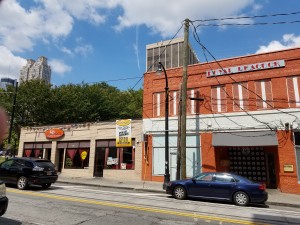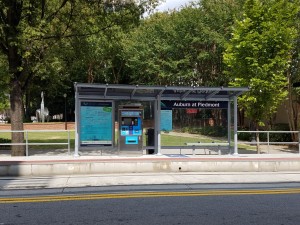The Sweet Auburn district of Atlanta is in serious need of a facelift. In an area that has had a serious impact on the development of rights for African-Americans, it would be easy to think that many people would want to preserve this historically rich area. However, it is in a serious state of disrepair. All along Auburn Avenue, it is easy to see the derelict structures all around. Windows are boarded up, stoops are in shambles, and the sidewalks are filled with holes in some areas. There has been some interest in the area, but when this happens, only certain parts are renovated. Only enough room is cleared to make way for the incoming store or possible tenant. This creates a problem when new businesses and restaurants move into the area because they are in freshly renovated parts of the street while being next door to a tenement that is falling apart. While there are still areas that are working hard to preserve and teach the value of the area, such as APEX Museum, it is not enough to properly protect the area. The historical value of the street is the most important part. If renovation occurs, there needs to be a very conscious and concentrated effort to maintain the value and history that is stored within the constructs of this street.
Auburn Avenue is one of the most well-known streets in Atlanta, mainly due to its history as one of the richest African-American streets in the country. In the link above, there is some basic information which will provide some background. The two images below are of The Royal Peacock, a lounge on Auburn Avenue. Overall, this lounge has retained a much higher quality than other structures in the area, mainly due to the fact that it is still running. If there were functioning businesses or residences at each location, then it would have a much brighter future.

Peacock circa 1950
Over time, Auburn Avenue has seen its fair share of activity, but it is most well known for being one of the richest African-American streets in the country in the early 1900s. However, it was not always known as Auburn Avenue. Wheat Street, as it was known before its name change in 1893, came about because many of the white citizens of the surrounding areas did not think that it had a name that fit with the area (Hatfield 1). Even though the African-Americans were creating and running successful businesses, they were still restricted by the Jim Crow laws of the time, which were rules and regulations that worked to enforce segregation based on race in many states. Even though slavery was abolished, these Jim Crow laws kept some aspects of slavery in effect, creating a rift between the two races. For this reason, Wheat Street/Auburn Avenue was well quite important to the history of America. By showing that they were able to create a successful community, the African-American communities created a certain degree of tension, but ultimately showed that they were capable of succeeding.
In today’s time, Auburn Avenue is not as prolific as it once was. Many of the previously influential and well-known businesses are currently in a state of disrepair, with the previous owners having moved on to other locations so that they could try to make money and progress with their interests. There are, however, some businesses that are still standing, and continuing to do some of the things that they once did. The Atlanta Daily World is one example of a successful business still standing. As discussed in the smaller post, the Atlanta Daily World is one of the oldest African-American run newspapers in the United States. Along Auburn Avenue, it is easy to see which owners take pride in their businesses, as they still have clean fronts along a street that is in a severe state of disrepair.
Over time, there have been tons of businesses that have moved into the area in an attempt to take advantage of the possible advances of the area as the city and other corporations attempt to reinvent the area. One good example of an attempt to reinvent the area is with the Atlanta Streetcar.
The Streetcar works well for what it is, but there are still some missing elements that would truly make it a worthwhile addition to the area.One of the biggest issues is that the track does not stretch far enougCrossing only 2.7 miles of Atlanta, it does not allow ease of access to any other important areas and locations within the city. However, this newly constructed addition to the city is effectively working to provide the beginning steps of the face lift needed on the street. Upon its expansion, it will entice more people to come in and revise the area that is Sweet Auburn. People from all over the city will be able to flock there and experience the wealth of historical value that is hidden within.
The Sweet Auburn district is located in an area in which there is a great opportunity for the community to prosper. With its rich cultural and political history, the right forces need to come into play so that there is a possibility for further development. When looking some of the businesses and well-known structures on Auburn Avenue, such as the King Center, there are apparent problems. According to the website for the King Center, nearly one million people visit the structure each year to look at the exhibits and learn more about the Civil Rights struggle and the many people that worked to better the country. The King Center is simply a few blocks from some of the other previously important buildings. However, with windows boarded up, doorsteps crumbling, and bricks cracking, there is little incentive for these people to go down and experience some of the other culturally charged offerings of the city.
One way in which Sweet Auburn has a chance of being revitalized is with heritage tourism. Heritage tourism is defined as, “traveling to experience the places, artifacts, and activities that authentically represent the stories and people of the past and present” (The National Trust for Historic Preservation). With such a diverse and rich history, the Sweet Auburn district has the opportunity to be an incredibly popular site. People from all over could come and see the places where some of the most influential people worked for change in the country.
Sweet Auburn has many people working diligently to try and maintain its preservation, and in fact several of them are non-profit. Of these, the most notable is Sweet Auburn Works, which is a revitalization project to try and keep the area from being completely commercialized and losing its significance. Due to the work of these organizations, as well as investments from new owners in the area, there appears to be a chance for the area. People such as Gene Kansas and Peter Thomas, entrepreneurs and real estate investors, have invested money in the area to try and reconstruct and provide a facelift for some of the buildings in the area. However, no matter how much money is filtered into the area, it is important to also bring some coverage to the area so that more and more people can see what exactly is going on and see the opportunities to visit. One form of coverage will be provided for by Thomas, who works with “The Real Housewives of Atlanta.” He will be bringing the members of the cast to the area, and because the show has millions of viewers, it is likely to drive up interest in the area.
With people such as Thomas and Kansas working on Auburn Avenue, there is no doubt that the historical value of the area will be preserved. With such a rich history that has influenced that evolution of the entire country, a complete destruction and rebuilding of Auburn Avenue would be a terrible move. However, it is possible to bring it into the modern age while still keeping the significance there. By reworking the exterior of the buildings and making sure they are all up to code, it would be possible to bring back a large number of visitors to the area. One of the main issues of the area at this point in time is that there are some structures and businesses that are successful, but there are others withing a few hundred feet that are decomposing. There is a lot of good potential in the area, but there first needs to be a focus on the more impactful areas.
Auburn Avenue is an area that offers a wealth of history in only a few short blocks. Starting as one of the richest African-American streets in the country and then being the birthplace of Dr. Martin Luther King Jr., who would go on to be on of the key leaders of the civil rights movement in America. Renovation of the area is not the solution. There need to be regulations in place that allows companies to come in and work on the area, but to maintain the historical value, it is necessary for them to have certain constraints as to what they are able to do. Bulldozing the entire street is not the solution. Going in and redoing the brickwork, fixing the stoops, and repaving the sidewalks are all little cosmetic changes that would make a world of difference. Going in and redoing the insides of the buildings is also important, but it is imperative that they don’t waste the space and make it possible for future people to examine.
Citations:
“After Decades of Neglect, Glimmers of Hope for Sweet Auburn.” Atlanta Magazine. N.p., 7 Apr. 2015. Web. 12 Sept. 2016.


Leave a Reply